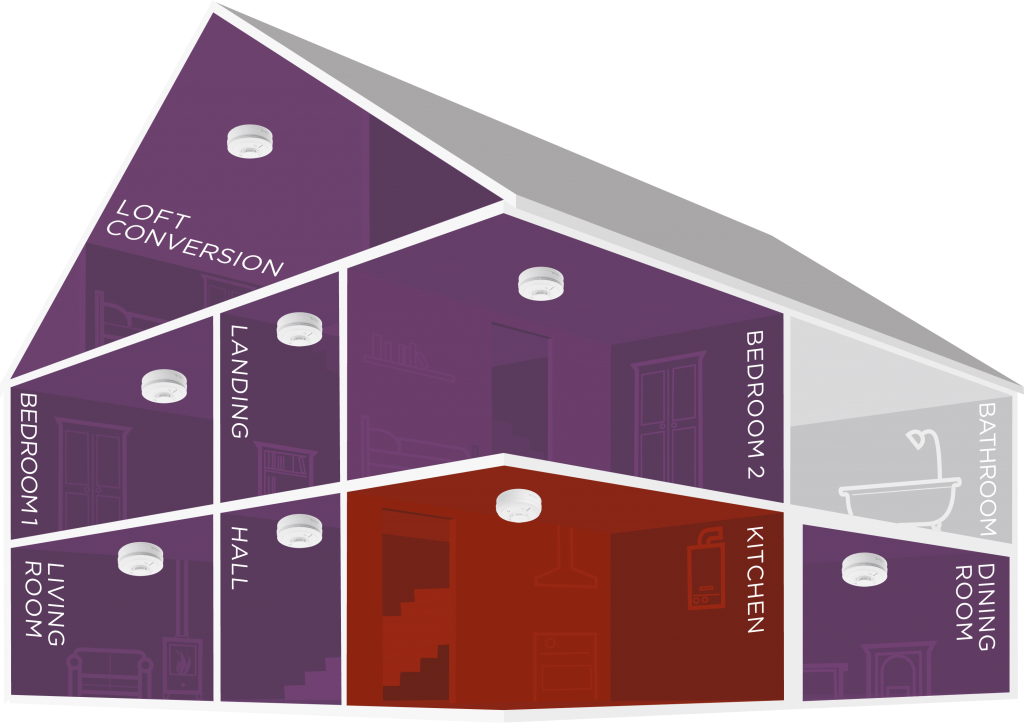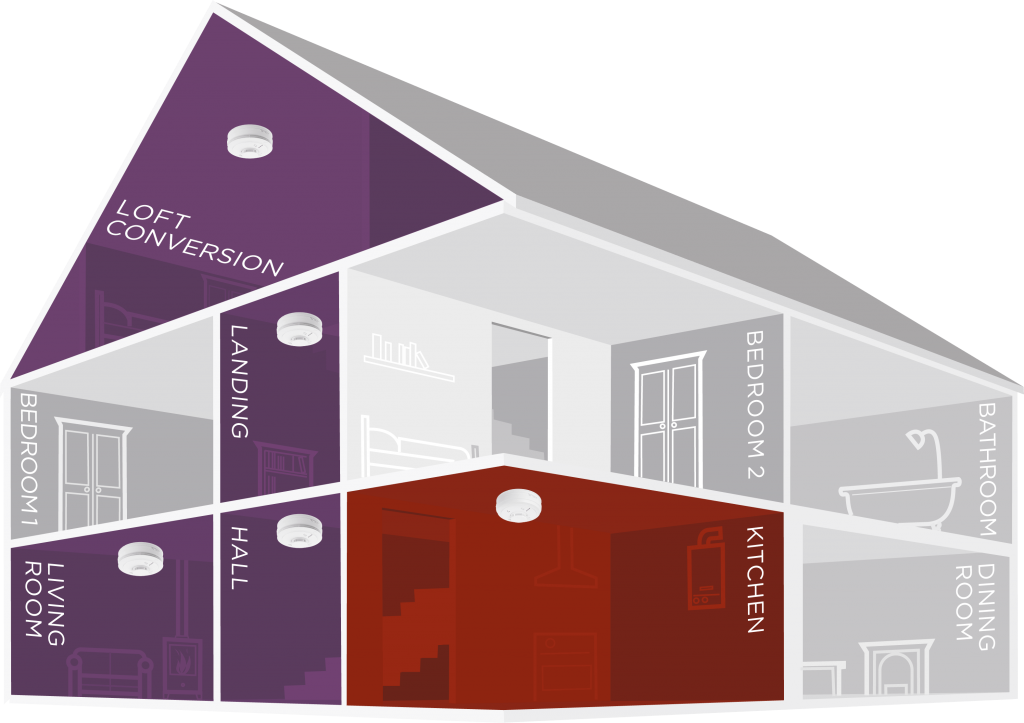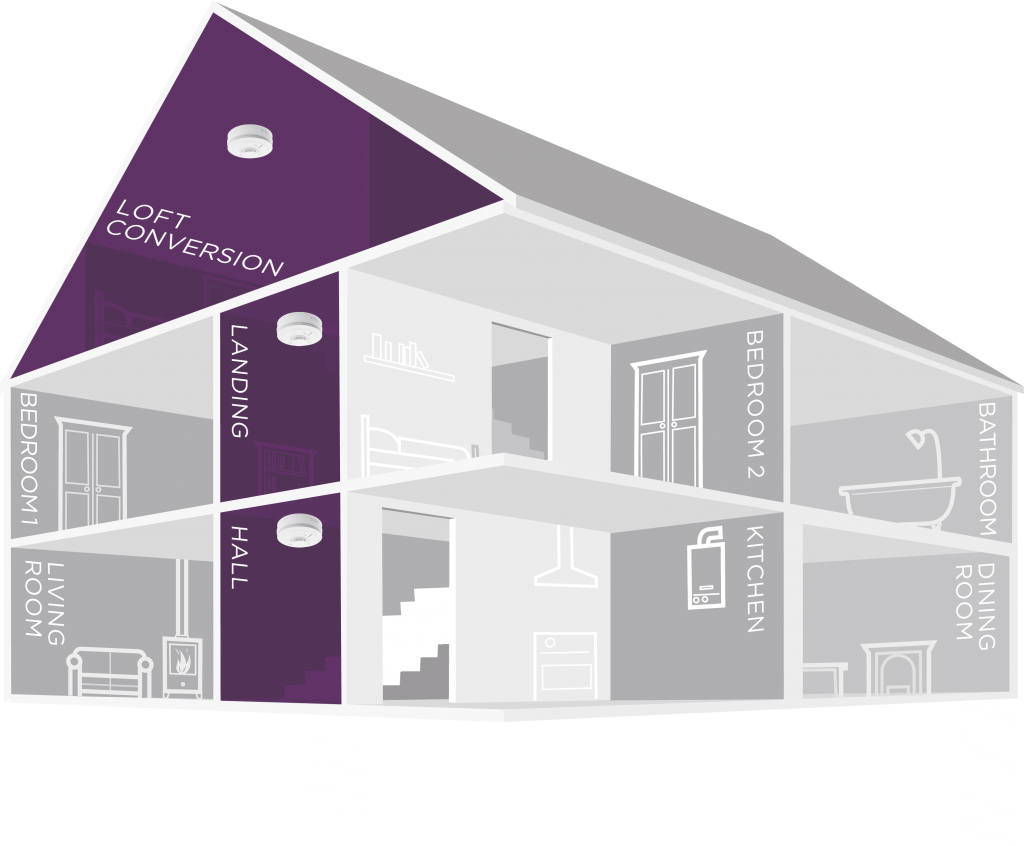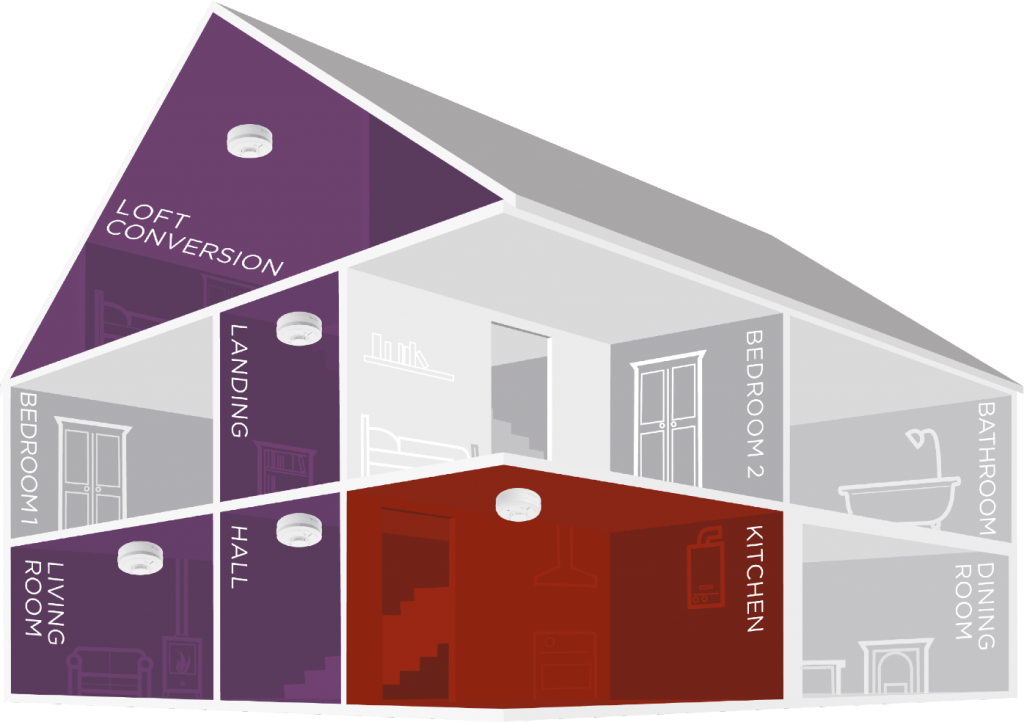At Ash Electrical we continuously use on all our installs and recommend Aico fire detection products due to there reputation, reliability and producing the highest quality alarms, but also continued innovation, exceptional service and unrivalled support.
British Standard BS5839-6:2019 covers specific recommendations for fire alarm systems in all domestic premises and covers both new-build and existing properties. The standard contains a large amount of detail on all aspects relating to the design and installation of fire alarm systems, but one area of it covers the type of alarm to install and the areas of the property to protect.
The Category of System
The standard states that the level of protection to the occupants needs to be directly related to the fire risk. However it does list three Categories of system to describe the level of protection the systems provide. Where and how many alarms are installed will affect how quickly a fire is detected – generally the higher the Category of system the higher the level of protection.

LD1
High Protection
All areas where a fire could start, e.g:
- Hallways
- Landings
- Living Room
- Kitchen
- Bedrooms
- Airing cupboards/ Meter cupboards

LD2
Medium Protection
Escape routes and high risk areas, e.g:
- Hallways
- Landings
- Kitchen
- Living Room

LD3
Minimum Protection
Escape routes, e.g:
- Hallways
- Landings
Grade D1, LD2D

Rented
New Build / Existing
Grade D1
A system of one or more mains powered detectors, each with a tamper-proof standby supply consisting of a battery or batteries.
Note D:
Heat detectors should be installed in every kitchen. A smoke detector should be installed in the principal habitable room. Where more than one room might be used as the principal habitable room, a smoke detector should be installed in each of these rooms.
The updated Alarm Grades
The changes to BS 5839-6:2019 include new grades covering the different types of alarm system, with Grade C being redefined, Grade D being replaced by D1 and D2 and Grade F replaced by F1 and F2.
Grade A: Separate detectors, sounders and central control and indicating equipment with back-up supply. Equipment must conform to other British Standards (BS EN 54)
Grade C: A system of fire detectors and alarm sounders (which may be combined in the form of smoke alarms) connected to a common power supply, comprising the normal mains and a standby supply, with central control equipment.
Grade D1: A system of one or more mains powered detectors, each with a tamper-proof standby supply consisting of a battery or batteries.
Grade D2: A system of one or more mains-powered detectors each with an integral standby supply consisting of a user- replaceable battery or batteries.
Grade F1: A system of one or more battery-powered detectors powered by a tamper-proof primary battery or batteries.
Grade F2: A system of one or more battery-powered detectors powered by a user-replaceable primary battery or batteries.
Fire – Building Regulations
There are different Fire Building Regulations across the UK, with England and Wales, Scotland and Northern Ireland all drawing from different documents and requiring different levels of protection. All of the Regulations cover a wide range of safety requirements including means of escape, internal fire spread and access for the fire and rescue service, but this page will focus on the fire alarm system itself.
England and Wales – Building Regulations Document B (Volume 1)
These regulations cover new builds, materially altered dwellings, loft conversations and certain building extensions for standard dwellings.
All dwellings should be provided with an alarm system to at least Grade D1/D2, Category LD3 – this means the installation of mains powered alarms with an integral back-up power supply within the escape routes of the property (i.e. hallways and landings). In addition, the Regulations also require a heat alarm to be installed in any kitchen areas where the kitchen is not separated from the circulation space or stairway by a door.
The Regulations state that optical smoke alarms are generally more suitable for installation in circulation areas (hallways and landings) adjacent to kitchens. Heat alarms are recommended for kitchens.
All alarms should be interconnected to ensure audibility throughout the property in event of an alarm being triggered.
The Regulations also reference the British Standard BS 5839-6:2019 and recommend that an alarm system is installed in-line with this Standard.

Scotland – Technical Handbook (Domestic) – Fire
These regulations now cover all properties to include private rented, social housing, new builds, materially altered dwellings, loft conversions, certain building extensions and any work that requires a building warrant.
All dwellings should be provided with either a Grade D or a long life Grade F alarm system installed as follows:
- At least one smoke alarm in the principal habitable room (commonly the living room)
- At least one smoke alarm in every circulation space on each storey (i.e. hallways and landings)
- At least one smoke alarm in every access room serving an inner room
- At least one heat alarm installed in every kitchen
Optical or Multi-Sensor alarms are recommended for the principle habitable room and all circulation areas. Heat alarms are recommended for kitchens.
Depending upon the specific layout of the property, the above generally equates to Category LD2.
All alarms should be interconnected to ensure audibility throughout the property in event of an alarm being triggered.
The Regulations also reference the British Standard BS 5839-6:2019 and recommend that an alarm system is installed in-line with this Standard.

Northern Ireland – Technical Booklet E
These regulations cover new build, materially altered dwellings, loft conversions and certain building extensions.
All dwellings should be provided with an alarm system to at least Grade D1/D2, Category LD2 – this means the installation of mains powered alarms with an integral back-up power supply within the escape routes of the property (i.e. hallways and landings), principal habitable room (generally the living room) and the kitchen.
The Regulations state that optical smoke alarms are generally more suitable for installation in circulation areas (hallways and landings) adjacent to kitchens. Heat alarms are recommended for kitchens.
All alarms should be interconnected to ensure audibility throughout the property in event of an alarm being triggered.
The Regulations also reference the British Standard BS 5839-6:2019 and recommend that an alarm system is installed in-line with this Standard.

Note that the above information is relevant to standard domestic properties up to three storeys with no individual floor level of over 200m². Further information can be found in Building Regulations Document B for England and Wales, Fire Technical Handbook – Domestic for Scotland and Technical Handbook E for Northern Ireland.
Additionally you can contact our Technical Team or your local Building Control Officer through your local Planning Authority.
Alarm Testing and Commissioning
Testing Hard-wired & RadioLINK Alarms (Smoke and Carbon Monoxide)
Step 1 – checking on battery back-up
Turn off the mains power to the alarm circuit and check that the green light is off
Listen for a couple of minutes to test that the alarm does not beep. Press and hold the test button for up to 10 seconds to ensure the alarm sounds and triggers any interconnected alarms
Step 2 – checking on mains power
Turn the mains power to the alarm back on. Check that the green power light is on
Press and hold the test button for up to 10 seconds to ensure the alarm sounds and triggers any interconnected alarms
Troubleshooting: If the green light does not come on check the circuit breakers, fuses, wiring etc.
For more information on testing please view the individual product instructions – these can be found on their product pages. For your reference here are some links to popular product instructions:
Ei160e Alarm Series Instructions
Ei3024 Multi sensor Alarm Instructions
Ei208 Carbon Monoxide Alarm Instructions
Ei450 Alarm Controller Instructions
Installation Certificates
There are many different types of Installation Certificates, but most of them will ask for the same type of information. Here is a guide to completing them:
System Grade
Alphabetical scale that describes the type of alarms that are installed in the system. The most common Grades for domestic installations are:
Grade D1 = A system of one or more mains-powered detectors, each with a tamper-proof standby supply consisting of a battery or batteries.
Grade D2 = A system of one or more mains-powered detectors, each with an integral standby supply consisting of a user-replaceable battery or batteries.
Grade F1 = A system of one or more battery powered detectors, powered by a tamper-proof primary battery or batteries.
Grade F2 = A system of one or more battery powered detectors, powered by a user-replaceable primary battery or batteries.
System Category
References the areas of coverage with the alarm system:
LD1 = Alarms in all rooms/areas apart from bathrooms, shower rooms and toilets
LD2 = Alarms in hallways and landings (circulation spaces & escape routes) plus alarms in the kitchen and living room (high risk areas)
LD3 = Alarms in hallways and landings (circulation spaces & escape routes)
System Testing – Installation Certificate
Once the system has been installed it should be tested and an installation certificate provided. Some certificates ask for a smoke/heat test to be performed on the alarms, however we do not recommend this as the results can be misleading and all Aico alarms are tested in smoke/heat/CO as part of the production process. We recommend testing using the test button on front of the alarms.
If your certificate requires reference to smoke/heat testing, you can use the following wording as a ‘variation’ if you are testing using the test buttons:
“A physical smoke/heat test has not been performed, having been substituted by following the testing recommendation contained within the Siting and Installation Instructions supplied by the manufacturer of the alarms installed.”
Smoke & Heat Alarm Installation Certificate
Carbon Monoxide Alarm Installation Certificate
User Instructions & Handing Over
- Many Installation Certificates require the occupier to be given written information on certain things such as operation of the system or action to be taken in the event of a fire
- The ‘User Instructions’ supplied with the alarms cover all of these essential points and must be handed over to the person who lives in the property once installation and testing is complete
- Extra copies of the instructions can be found on the individual product pages in the products section
- There is a blue dust cover provided with all alarms – this must be fitted over alarms if building work is still on-going to prevent contamination. When the work has finished remove the dust cover and give to the owner of the property. If work has not finished and you will not be returning to the property ensure that the owner knows they must remove the dust cover once building work has finished

